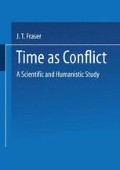Abstract
The umwelt of an animal comprises outward projections of organized, elementary sensations. The aggregates of signs and signals within the organism which determine this Umwelt form an internal chart of reality. In the case of man, the most significant such chart is what I have called the internal map of the mind. Regardless of the sophistication of this internal map, however, its contents may be conveniently thought of as a store of knowledge. Knowledge, so understood, is identifiable through behavior and, in the case of man, through language.
Access this chapter
Tax calculation will be finalised at checkout
Purchases are for personal use only
Preview
Unable to display preview. Download preview PDF.
References
If these conjectures appear too fanciful, one should remember that the sexual act is the most important biological function of the individual, beyond staying alive. Males of most advanced species participate in this ubiquitous ritual by injection, females by reception. It is not strange, therefore, to find the morphologies of sexual organs transposed into the forms and modes of knowledge, considering that the lineage of man is some 200,000,000 years old. The number of times that sexual organs were put to use during this period is very large.
This very recent psycholinguistic approach reminds one of John Stuart Mill’s work on language, first published in 1843. If one attempts to rectify the use of a vague term by giving it a fixed connotation, one endangers one of language’s “inherent and most valuable properties, that of being the conservator of ancient experience; the keeper-alive of those thoughts and observations of former ages which may be alien to the tendencies of the passing time .... Language is the depository of the accumulated body of experience to which all former ages have contributed their part and which is the inheritance of all yet to come.”
The languages involved in the comparative study are English, French, German, Gothic, Greek, Hebrew, Hungarian, Italian, Latin, Lithuanian, Old English, Old High German, Old Norse, Sanskrit, Slavic, and Spanish.
Studies of psycholinguistics hint at the active role that the perceiver plays in forming percepts. The argument is based on the observation that words, just as individual thoughts, are shaped or totally forgotten, yet these meanings remain unconscious, latent powers beneath dictionary definitions. Thus, both perceive and conceive denote mental activities related to grasping (understanding) as well as to creation. The Latin percipere contains the idea of “taking hold” from the Latin capere. The German begreifen (grasping an idea) originally meant “grasping with the hands.” For fifteen million years before the creation of a new mental concept came to be described as “grasping an idea,” women were grasped so as to make them conceive new life. When our distant ancestors sought a linguistic symbol that would represent those feelings which signal the birth of a yet nameless idea, they must have been moved by a sense of kinship between the two types of conceptions: the biological and the mental. The ancient meaning survives in our present use. The word “perception” is ambiguous. It means (1) sense oriented awareness of change and permanence in the self or in the environment, as well as (2) the internal events responsible for this awareness. This ambiguity is probably not accidental. The word reflects the ancient confusion about the reality of an external world. Bluntly put, is it “me” that I see projected out there, or is the “out there” something quite independent of “me?” Is time in me, projected on the external world, or is it out there perceived by me? The ambiguity implies an awareness that perception includes a creative stress, not unlike that of carnal knowledge. The tacit and erroneous assumption that the organism is a passive observer of the external world has been called the dogma of immaculate perception. The position taken by the theory of time as conflict is a diametrically opposite one: it is that of passionate perception. Such a stance is implicit in the extended Umwelt principle, put forth earlier.
Cf. Section four of this chapter where we learn about cultures that emphasize hearing over seeing.
It also became possible to abstract invariances from feelings and other sensations whose external sources could not be identified. With a private world of meaningful experience one might expect to see metaphor making emerge, and might speculate about the opposition between the deathless world of symbols and that of the inevitably aging bodies.
The painfulness of change from the unity of the mother into the twoness of mother and child is recorded in some languages. In English alone comes from the earlier all-one, used to describe the newborn as whole and one. The experience of loneliness is a corollary of being separate.
It must be remembered that modes of genital knowledge are not limited to members of the respective sex, and that preferences for the female type of genital knowledge are not to be mistaken for a statement on the social status of women.
Belief in reductionism, wrote W.H. Thorpe (1975), subconscious though it may be, has an effect on the sanity of modern man. Reductionism today is a mask for nihilism, which in its contemporary form is not nothingness, but “nothing but-ness.”
Rights and permissions
Copyright information
© 1978 Springer Basel AG
About this chapter
Cite this chapter
Fraser, J.T. (1978). Science as Truth. In: Time as Conflict. Wissenschaft und Kultur, vol 35. Birkhäuser, Basel. https://doi.org/10.1007/978-3-0348-6516-6_10
Download citation
DOI: https://doi.org/10.1007/978-3-0348-6516-6_10
Publisher Name: Birkhäuser, Basel
Print ISBN: 978-3-0348-6518-0
Online ISBN: 978-3-0348-6516-6
eBook Packages: Springer Book Archive

